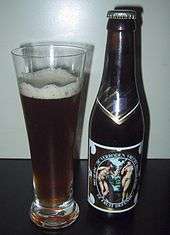Hoegaarden Brewery
 | |
| Brewery | |
| Industry | Alcoholic beverage |
| Founded | 1445 |
| Headquarters | Hoegaarden, Belgium |
| Products | Beer |
| Owner | Anheuser-Busch InBev |
| Website | hoegaarden.com |
Hoegaarden Brewery (/ˈhoʊɡɑːrdən/; Dutch pronunciation: [ɦuˈɣaːrdə(n)]) is a brewery in Hoegaarden, Belgium, and the producer of a well-known wheat beer.
History
A village called Hoegaarden, near Tienen in Flanders, is the modern birthplace of Belgian white beer. Records of brewing in the village date back to 1445, when the local monks were enthusiastic brewers, but the tradition died out in the 1950s.[1]
Early and recent history
The village of Hoegaarden had been known for its witbieren (white beers) since the Middle Ages. In the nineteenth century, the village had thirteen breweries and 9 distilleries;[2] however, in 1957, the last local witbier brewery, Tomsin, closed its doors. Pierre Celis, a milkman who had grown up next to the brewery and sometimes helped with brewing, decided some ten years later to try to revive the style. He started a new brewery, called de Kluis, in his hay loft.[3] [4] Celis used the traditional ingredients of water, yeast, wheat, hops, coriander, and dried Curaçao orange peel known as Laraha. In the 1980s, with demand for the product continuing to grow, Celis bought Hougardia, a former lemonade factory, to expand his brewing operations.[2]
After a fire in 1985, several brewers offered their help — as is traditional in Belgium. One of these was the largest brewer in the country, called Interbrew (after a merger with AmBev, renamed InBev). Interbrew lent money for the purchase of other buildings to rebuild the brewery. Over time, Celis felt very strongly that the company used the loan to pressure him to change the recipe to make the beer more "mass market".
Celis goes to Texas and Michigan
Celis decided instead to sell them the brewery, and with the proceeds, he moved to the United States, where he set up the Celis Brewery in Austin, Texas, to continue making witbier to what he described as the original Hoegaarden recipe. It was later acquired by Miller Brewing. Celis never fully relocated to Texas, but his daughter and son-in-law, who operated the brewery, did. Miller ultimately closed the brewery and sold the equipment and brand names to Michigan Brewing Company.
The witbier Celis brewed in Texas, which he described as the original Hoegaarden recipe, was at the same time brewed in Belgium, first by Brouwerij De Smedt and then later by Brouwerij van Steenberge. This beer, Celis White, is still being brewed in Belgium by Brouwerij van Steenberge, and was brewed in the U.S. by Michigan Brewing Company, which went bankrupt and sold the name.
Hoegaarden since InBev takeover
In November 2005, InBev announced the forthcoming closure of the brewery in Hoegaarden, among other changes in Belgium. The brewery was to close in late 2006 with production moving to InBev's larger brewery in Jupille. The beer Julius was said to have been an immediate casualty, and sparked worries that all beers that were bottle conditioned would be changed. The closure sparked protests from Hoegaarden locals, upset at the loss of the town's most famous symbol and largest employer.
The move was never completed. The brewers in Jupille remained unsatisfied with local production of the witbier, so on September 10, 2007, Inbev decided to keep the production in Hoegaarden. Inbev also decided to invest part of a 60 million Euro budget in the Hoegaarden site to upgrade the facilities.
Types of Hoegaarden beer
- Wheat beer
- First brewed in 1445 Hoegaarden is a witbier and is spiced with coriander and orange peel. It is unfiltered and therefore has a cloudy appearance. In many bars, it is customarily drunk with a slice of lemon. It has an alcoholic content of 4.9%.[5]
- Citron
- Launched in 2008, 3% ABV.
- Grand Cru
- Launched in 1985, 8.5% ABV.
- Julius
- An 8.8% blonde ale, with a dry taste formed through triple-hopping.

- Forbidden fruit
- (French: Fruit Defendu. Flemish: Verboden Vrucht) An 8.5% dark ale, with complex spicing.
- DAS
- A 5% spiced amber ale, from a 1931 recipe. As of 2009 not anymore in production.
- Spéciale
- Launched in 1995, 5.7% ABV. Hoegaarden Spéciale is a full-bodied, rich Belgian-style wheat beer. It has a characteristic fruity taste and clear spicy notes of clove and coriander. Slightly citrus and rounded off by a smoky, sweet vanilla quality, its sweet and sour flavour is well balanced. Spéciale is averagely bitter but with hardly any aftertaste. It is available from October to January.
References
- ↑ Calagione, Sam, foreword; Hampso, Tim, General editor (2008). The beer book (1st American ed.). New York: DK Publ. p. 204. ISBN 9780756639822.
- 1 2 "Likeurtjes proeven naast de brouwerij". Het Nieuwsblad. 3 January 2005. Retrieved 7 February 2010.
- ↑ Tim Webb, Good Beer Guide to Belgium and Holland ISBN 1-85249-174-4, page 143
- ↑ Jackson, Michael (1992). The Great Beers of Belgium (2nd ed.). Antwerpen: Coda. pp. 111–112.
- ↑ "Hoegaarden at RateBeer". Retrieved 2012-07-07.
- ↑ "Hoegaarden". hoegaarden.com.
External links
| Wikimedia Commons has media related to Hoegaarden Brewery. |